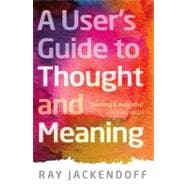
Note: Supplemental materials are not guaranteed with Rental or Used book purchases.
Purchase Benefits
Looking to rent a book? Rent A User's Guide to Thought and Meaning [ISBN: 9780199693207] for the semester, quarter, and short term or search our site for other textbooks by Jackendoff, Ray. Renting a textbook can save you up to 90% from the cost of buying.
| Foreword | p. ix |
| Language, Words, and Meaning | |
| Why do we need a User's Guide to thought and meaning? | p. 3 |
| What's a language? | p. 6 |
| Perspectives on English | p. 14 |
| Perspectives on sunsets, tigers, and puddles | p. 18 |
| What's a word? | p. 22 |
| What counts as the same word? | p. 28 |
| Some uses of mean and meaning | p. 32 |
| "Objective" and "subjective" meaning | p. 38 |
| What do meanings have to be able to do? | p. 41 |
| Meanings can't be visual images | p. 51 |
| Word meanings aren't cut and dried (You can't avoid the slippery slope) | p. 56 |
| Not all the meaning is in the words | p. 63 |
| Meanings, concepts, and thoughts | p. 70 |
| Does your language determine your thought? | p. 74 |
| Consciousness and Perception | |
| What's it like to be thinking? | p. 81 |
| Some phenomena that test the Unconscious Meaning Hypothesis | p. 87 |
| Conscious and unconscious | p. 92 |
| What does "What is consciousness?" mean? | p. 96 |
| Three cognitive correlates of conscious thought | p. 103 |
| Some prestigious theories of consciousness | p. 108 |
| What's it like to see things? | p. 114 |
| Two components of thought and meaning | p. 121 |
| Seeing something as a fork | p. 129 |
| Other modalities of spatial perception | p. 134 |
| How do we see the world as "out there"? | p. 139 |
| Other "feels" in experience | p. 143 |
| Reference and Truth | |
| How do we use language to talk about the world? | p. 155 |
| Mismatching reference in conversation | p. 162 |
| What kinds of things can we refer to? (Cognitive metaphysics, Lesson 1) | p. 166 |
| Reference files for pictures and thoughts | p. 173 |
| More cognitive metaphysics: Persons | p. 181 |
| What's truth? | p. 187 |
| Problems for an ordinary perspective on truth | p. 191 |
| What's it like to judge a sentence true? | p. 195 |
| Noticing something's wrong | p. 200 |
| Rationality and Intuition | |
| What's it like to be thinking rationally? | p. 207 |
| How much rational thinking do we actually do? | p. 216 |
| How rational thinking helps | p. 219 |
| Some pitfalls of apparently rational thinking | p. 223 |
| Chamber music | p. 227 |
| Rational thinking as a craft | p. 232 |
| Some speculation on science and the arts | p. 237 |
| Learning to live with multiple perspectives | p. 243 |
| References and further reading | p. 249 |
| Index | p. 265 |
| Table of Contents provided by Ingram. All Rights Reserved. |
The New copy of this book will include any supplemental materials advertised. Please check the title of the book to determine if it should include any access cards, study guides, lab manuals, CDs, etc.
The Used, Rental and eBook copies of this book are not guaranteed to include any supplemental materials. Typically, only the book itself is included. This is true even if the title states it includes any access cards, study guides, lab manuals, CDs, etc.